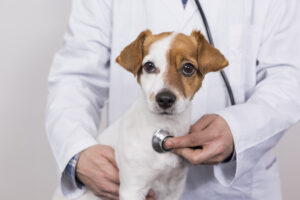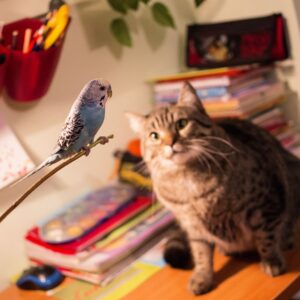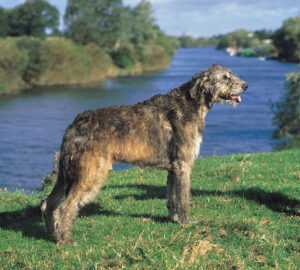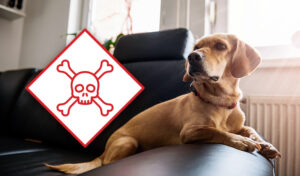Posts Tagged ‘large animal vet’
Dr. Olsen’s Pet Spotlight: The Leonberger Dog Breed
 At Olsen Veterinary Clinic, we celebrate all breeds, and today, we’re delighted to spotlight the Leonberger—a breed renowned for its gentle temperament, impressive size, and striking appearance. Whether you are a seasoned dog owner or considering adding a Leonberger to your family, understanding this breed’s unique characteristics is essential.
At Olsen Veterinary Clinic, we celebrate all breeds, and today, we’re delighted to spotlight the Leonberger—a breed renowned for its gentle temperament, impressive size, and striking appearance. Whether you are a seasoned dog owner or considering adding a Leonberger to your family, understanding this breed’s unique characteristics is essential.
Origin and History
The Leonberger hails from Leonberg, Germany, where Heinrich Essig, a dog breeder, sought to create a breed that embodied the grandeur and loyalty of a lion. By crossbreeding Saint Bernards, Newfoundlands, and Great Pyrenees, Essig succeeded in developing the Leonberger, which soon became a favorite among European royalty. The breed was officially recognized in the late 19th century and has since garnered a loyal following worldwide.
Physical Characteristics
Leonbergers are a sight to behold. Males typically weigh between 110 to 170 pounds, while females range from 90 to 140 pounds. They stand 26 to 32 inches tall at the shoulder, exuding an aura of strength and nobility. Their dense, water-resistant double coat comes in shades of lion-yellow, golden to red-brown, often with a black mask. Regular grooming is essential to maintain their majestic coat and reduce shedding.
Temperament and Behavior
Despite their imposing size, Leonbergers are known for their gentle and friendly nature. They are affectionate, loyal, and thrive on human companionship, making them excellent family pets. Their intelligence and eagerness to please make them highly trainable, although early socialization and obedience training are crucial. Leonbergers are known for their calm demeanor, but they also possess a playful side and enjoy various activities, from hiking to swimming.
Health and Lifespan
Leonbergers are generally healthy, with a lifespan of 8 to 10 years. However, like all breeds, they are prone to specific health issues, including hip dysplasia, elbow dysplasia, and certain types of cancer. Regular veterinary check-ups, a balanced diet, and appropriate exercise are vital to ensuring their well-being. At Olsen Veterinary Clinic, we emphasize preventative care and offer tailored health plans to keep your Leonberger in optimal condition.
Exercise and Activity
Given their size, Leonbergers require regular exercise to maintain their physical and mental health. Daily walks, play sessions, and opportunities to run in a secure area are beneficial. They excel in activities like agility, obedience, and even water rescue, thanks to their strong swimming abilities. Engaging your Leonberger in diverse activities will keep them happy and prevent boredom-related behaviors.
Grooming Needs
Leonbergers have a thick, double coat that requires consistent grooming. Weekly brushing helps prevent mats and tangles, and more frequent grooming may be necessary during shedding seasons. Bathing should be done as needed, and regular checks of their ears, teeth, and nails are essential parts of their grooming routine. At Olsen Veterinary Clinic, we offer comprehensive grooming services to help keep your Leonberger looking and feeling their best.
Leonbergers and Families
Leonbergers are known for their exceptional compatibility with families. They are patient and gentle with children, often forming strong bonds with them. Their protective yet non-aggressive nature makes them excellent watchdogs without being overly territorial. However, due to their size, supervision around small children is recommended to prevent accidental knock-overs.
The Leonberger is a remarkable breed that combines beauty, strength, and a loving temperament. They make wonderful companions for those who can accommodate their size and grooming needs. At Olsen Veterinary Clinic, we are passionate about providing the best care for your Leonberger, ensuring they lead a healthy, happy life. Whether you’re a current Leonberger owner or considering bringing one into your home, our team is here to support you with expert advice and services.
For more information or to schedule a consultation, please contact Olsen Veterinary Clinic. We look forward to helping you and your Leonberger thrive together.
The Importance of Regular Veterinary Check-ups
 Regular veterinary check-ups are crucial for maintaining the overall health and well-being of your pets. These routine visits play a key role in preventative care and early detection of health issues. Here are some reasons why regular veterinary check-ups are important.
Regular veterinary check-ups are crucial for maintaining the overall health and well-being of your pets. These routine visits play a key role in preventative care and early detection of health issues. Here are some reasons why regular veterinary check-ups are important.
Preventative Care:
Regular check-ups allow veterinarians to administer vaccinations, parasite control, and dental care. Preventative measure can help protect your pet from various illnesses, ensuring they lead a healthier longer life.
Early Detection of Health Issues:
Pets, like humans, can develop health issues that may not be immediately apparent. Regular check-ups enable veterinarians to detect potential health problems early, often before symptoms become severe. Early detection can significantly improve the prognosis and treatment outcomes.
Disease Screening:
Veterinary check-ups may include screenings and tests for common pet diseases. These screenings can help identify conditions such as diabetes, kidney disease, and certain types of cancer in their early stages, allowing for timely intervention.
Dental Health:
Dental issues are common in pets, and they can lead to various health problems if left untreated. Regular veterinary visits often include dental examinations and cleanings, promoting good oral health and preventing dental diseases.
Nutritional Guidance:
Veterinarians can provide guidance on proper nutrition based on your pet’s age, breed, and health condition. A well-balanced diet is essential for maintaining your pet’s overall health and preventing nutrition-related issues.
Behavioral Assessment:
Veterinarians can assess your pet’s behavior during routine visits. Changes in behavior may be indicative of underlying health issues and addressing them early can prevent further complications.
Weight Management:
Maintaining a healthy weight is crucial for your pet’s well-being. Regular check-ups allow veterinarians to monitor your pet’s weight and provide guidance on nutrition and exercise to prevent obesity-related health issues.
Senior Pet Care:
As pets age, their healthcare needs may change. Regular check-ups become even more critical for senior pets to monitor and address age-related conditions, such as arthritis, dental problems, and organ dysfunction.
Client Education:
Veterinary visits are an opportunity for pet owners to learn about their pet’s specific needs, behaviors, and potential health risks. Education from veterinarians empowers pet owners to provide the best care possible.
In summary, regular veterinary check-ups are essential for preventative care, early detection of health issues, and ensuring that your pets lead healthy and happy lives. Establishing a consistent schedule of veterinary visits can contribute significantly to the overall well-being of your beloved companions. Contact our office today to schedule yours or if you have any questions.
Should Your Dog Get a Choker Collar? Here’s What You Need to Know
 Whether or not your dog should wear a chain choker collar is a matter of debate among dog trainers, veterinarians, and animal welfare organizations. There are several factors to consider before deciding to use a chain choker collar:
Whether or not your dog should wear a chain choker collar is a matter of debate among dog trainers, veterinarians, and animal welfare organizations. There are several factors to consider before deciding to use a chain choker collar:
1 Training Methodology: Chain choker collars are often used in training as a correction tool. However, they are associated with aversive training methods that rely on punishing undesirable behaviors through discomfort or pain. Many modern dog trainers advocate for positive reinforcement-based training methods, which focus on rewarding desired behaviors rather than punishing unwanted ones.
2 Breed and Size of the Dog: Smaller or more delicate dog breeds may be more vulnerable to injury when using chain choker collars. Breeds with thin necks, like Greyhounds, may be at a higher risk.
3 Health and Behavior Issues: Some dogs may have underlying health issues or behavioral problems that make the use of chain choker collars risky or inappropriate. For example, dogs with respiratory problems, brachycephalic breeds (i.e., Bulldogs), or fearful and aggressive should not be subjected to such collars.
4 Training Experience: If you are not experienced in using chain choker collars correctly, there is a risk of causing harm to your dog or reinforcing negative behaviors unintentionally. It is crucial to learn how to use these collars properly if you choose to use them.
5 Alternatives: There are many alternative training tools and methods available that can effectively train dogs without resorting to aversive methods. Positive reinforcement, clicker training, and head halters are examples of more humane and effective training tools.
6 Consultation with a Professional: If you are considering using a chain choker collar, it is strongly recommended that you consult with a professional dog trainer or behavioralist who can assess your dog’s specific needs and help you make an informed decision.
7 Local Laws and Regulations: Some places have laws and regulations that restrict or even ban the use of certain dog collars, including chain choker collars. Be sure to check your local laws and follow them accordingly.
If you have any questions about this or anything else, don’t hesitate to contact our office.
Dr. Olsen’s Breed Spotlight: The Tibetan Mastiff

Tibetan Mastiff
The Tibetan Mastiff is a large-size Tibetan dog breed. It has a medium to long double coat and is found in many colors. These can be solid black, black and tan, various shades of red (from pale gold to deep red), and bluish gray. Sometimes, they can have white markings around their neck, chest, and legs.
The term mastiff goes back to when the Europeans first went to Tibet. They used the term to refer to nearly all large dog breeds in the West. Early Western visitors misnamed several of its breeds through this process. For example, the Tibetan terrier is not a terrier, and the Tibetan spaniel is not a spaniel.
In the early 20th century, the Prince of Wales, George, introduced a pair of Tibetan Mastiffs to the United Kingdom, which caused the breed to become prevalent enough in England to be shown at the Crystal Palace show in 1906. Since 1980, the breed has been gaining in popularity worldwide.
The Tibetan Mastiff is a primitive breed and retains the general hardiness that would be required of them to survive in the harsh environment of Tibet, Ladakh, and other high-altitude Himalayan regions. Because of this, they tend to have strong instinctive behavior, including canine pack behaviors. These help the breed survive in harsh environments. It has maintained many of the same biological processes as wolfs and other animals.
The dog has a long, double coat whose length depends ultimately on the climate. Uniquely, the Tibetan Mastiff lacks the unpleasant big-dog smell that affects many other large dog breeds. Their coat can shed dirt and odors on its own. Many of the dogs shed somewhat throughout the year, but there is generally one great molt in late Winter or early Spring.
Tibetan Mastiffs have a life expectancy of around 10-16 years, but this span can vary. Generally, the breed has fewer genetic health problems than many other breeds. However, cases can be found of hypothyroidism, entropion, ectropion, distichiasis, skin problems, etc. As with most large breeds, some will suffer from elbow or hip dysplasia.
Hypothyroidism is common in Tibetan Mastiffs, along with many other large “northern” breeds. They should be tested periodically throughout their lives using a complete thyroid panel. However, because the standard thyroid levels were established using domestic dog breeds, test results must be considered in the context of what is “normal” for the breed, not what is standard for all breeds. Many Tibetan Mastiffs will have “low” thyroid values, but no clinical symptoms. Vets and owners differ on the relative merits of medicating dogs that test “low” but are completely asymptomatic.
The Tibetan Mastiff is sure to be a large lovable friend for any owner. Feel free to contact Dr. Olsen at Olsen Veterinary Clinic with any questions at 618-656-5868.
Can Cats and Birds Cohabitate?
 Cats and birds are natural opposites. Some cats won’t care about birds at all. Other times, the cat’s instinct to pounce, capture, and “play” with the bird will emerge. Either way, if you have a cat and bird cohabitating, it is important to have the proper precautions in place to keep both animals safe and healthy.
Cats and birds are natural opposites. Some cats won’t care about birds at all. Other times, the cat’s instinct to pounce, capture, and “play” with the bird will emerge. Either way, if you have a cat and bird cohabitating, it is important to have the proper precautions in place to keep both animals safe and healthy.
Cats can kill or hurt a bird very easily. With its sharp claws, it can wound the bird and possibly even give it an infection. Cats also pull out important feathers needed for flight, balance, and warmth. They can cause serious mental trauma to a bird that has endured an attack or threat. Cats can even eat small birds. Even though a cat is more dangerous to a bird than a bird is to a cat, bigger birds can seriously hurt a cat. With their strong beaks and claws, they could grab and bite a cat.
Even with the risks, there are ways that you can keep both the cat and bird safe. First, secure the bird cage in a serious manner. Make sure that the cat cannot get inside or knock the bird cage over. Small cages are often placed on tables and are easily knocked over. Make sure the cage is heavy enough that the cat cannot push it around. Be sure to use cage locks or carabiners to make sure the cat cannot open the bird cage doors.
Next, keep them in separate rooms. If you keep the bird cage in a room that the cat is not allowed it, you can avoid the extra stress that a stalking cat can cause for a bird.
Lastly, try and introduce your bird to your cat. It is typically a very slow process, and it starts with allowing your caged bird and cat to see each other from a distance. Eventually, you can lessen the distance between the two after ensuring both are comfortable and not stressed. Some people who have cats that show no signs of going into predator mode will take their bird out of its cage and allow the two to see each other without bars in the way. If you feel comfortable trying this, it must be done with great caution and awareness in case your bird tries to jump out of your hands, or your cat tries to pounce on the bird.
Cats and birds can cohabitate, if the owner takes proper precautions to keep both animals safe and calm. If you have any questions, feel free to contact Dr. Olsen at Olsen Veterinary Clinic at 618-656-5868.
Holiday Pet Gift Guide – 2021
 The holidays are a time for giving, and you can’t forget about your pets or a pet-lover in your life. I’ve assembled a list of the best pet gifts around to show your furry loved ones you care and help them participate in the holiday spirit.
The holidays are a time for giving, and you can’t forget about your pets or a pet-lover in your life. I’ve assembled a list of the best pet gifts around to show your furry loved ones you care and help them participate in the holiday spirit.
The easiest gift is that of more toys for your pet. You can get new toys you think they would like or replace the favorites that always seem to go missing. Here are some cute toy options that your pet would love. Here is a cute Christmas pickle dog toy. Here is a winter rope dog toy. Here is a cute snowman cat toy. Here is a catnip-based reindeer cat toy.
More practical, you could get new essentials like water or food bowls or new leashes. Items like these are always welcome since they get used daily by pets. Here is a nice modern option that is useful and still looks nice in your home. Here is the link.
For a more unique gift, you could get a pet DNA kit to see what their history is as an animal. For some kits, you can learn about their preferences as an individual animal. An example cat DNA test is linked here. Here is a dog DNA test. Here is a pet food and environmental intolerance test to see what bothers your pet.
You could also get your pet a nice jacket to keep them extra warm in the cold winter months. An example one for your dog is linked here. Maybe you’d like a more fun outfit to wear on the special holiday. An example is linked here.
Perhaps your dog likes to stick their head out the window. Some protective goggles for their eyes can be found linked here.
For the pet-lover in your life, you could get them a personalized pin for them to display their furry friend with pride. A handmade pin can be found linked here.
Maybe you are looking to splurge on your pet this winter. If your pet wants to go outside and is not allowed, or maybe they are getting old and can’t move as much as they used to but still wants to enjoy the outdoors, they could use a stroller like this one linked here to enjoy nature. Another splurge item could be this activity monitoring pet tracker. It’ll allow you to stay on top of your pet’s health.
Sharing the season of giving with your pets will only make it more enjoyable. If you have any questions, feel free to contact Dr. Olsen at 618-656-5868 or send him an email here!
Dr. Olsen’s Breed Spotlight: The Irish Wolfhound
 For this next breed spotlight, I will be introducing you to the Irish wolfhound, likely for the first time. This dog is calm, dignified, and the tallest breed of dog (sorry Great Danes). Early ancestors of Irish wolfhounds were fearless, big-game hunters who could dispatch a wolf in single combat. Today, they are the most serene and agreeable of companions.
For this next breed spotlight, I will be introducing you to the Irish wolfhound, likely for the first time. This dog is calm, dignified, and the tallest breed of dog (sorry Great Danes). Early ancestors of Irish wolfhounds were fearless, big-game hunters who could dispatch a wolf in single combat. Today, they are the most serene and agreeable of companions.
The amiable Irish Wolfhound is an immense and muscular hound. They are built along classic Greyhound lines, capable of great speeds at a gallop. A male might stand nearly three feet at the shoulder and can weigh up to 180 pounds. Females will run smaller but are still a very large dog. They have a rough and hard coat that can come in many colors. They can be white, gray, brindle, red, black, and fawn. Irish wolfhounds are way too serene to be fierce guard dogs, but the mere sight of the size of these dogs are enough to deter intruders. Irish wolfhounds are characteristically patient with kids, but their size does require supervision when they are around small children.
The history of this wolfhound goes back to the breeding of indigenous large dogs of Britain to the Middle Eastern coursing hounds that were bartered around the known world in the earliest days of international trade. By the time the Roman Empire had gained a toehold in the British Isles, the giant hounds of Ireland were already long established. In the year 391, the Roman consul received a gift of seven of these hounds that “all Rome viewed with wonder”. These majestic hunters, whose motto was “gentle when stroked, fierce when provoked”, were used on such quarry as the now-extinct Irish elk, a massive, ferocious beast said to stand six feet at the shoulder. In 15th-century Ireland, wolves were overrunning the countryside. The Irish hounds, already renowned big-game hunters, began to specialize on wolves. By the late 1700s, when wolves and other big-game animals of Ireland were hunted to extinctions, Irish wolfhounds lost their job and nearly went extinct themselves. This is a case of a breed doing its job too well for its own good. In 1862, British army captain George Augustus Graham began scouring the country for remaining specimens of Ireland’s national hound. Graham made it his life’s work to protect, standardize, and promote the breed. Today, his name is still spoken with reverence wherever Irish wolfhound fanciers gather.
The coats of Irish wolfhounds have two layers; the outer being harsh and wiry with the under being very soft. They shed throughout the year, but not in an excessive amount. Unlike many other double-coated breeds, Irish wolfhounds don’t “blow out” their coats during an annual or semi-annual shedding season. Irish wolfhounds retain a strong instinct to hunt and chase prey, so they should only be allowed off the leash in areas that are securely fenced. As adults, Irish wolfhounds can become couch potatoes if allowed to, but regular exercise like long walks and play sessions help keep them physically and mentally healthy. A home with a large, fenced area is necessary to provide the environment needed for this breed to thrive. The breed can also exercise mind and body by participating in canine sports like tracking, agility, and lure coursing.
These gentle giants are sure are a breed with a rich history. Their ancestors’ traits reveal themselves with their passion for hunting and need for mental and physical exercise. Generally, these dogs make excellent companions for anyone with enough land to satisfy their need to run. With any questions, please feel free to contact Dr. Olsen at 618-656-5868.
What You Need To Know About Pet Poisons
 No pet owner wants to hurt their furry friend, but sometimes it is inevitable. Accidental poisonings can be prevented with simple switches in your home. One of the easiest ways to prevent an accidental poisoning is to watch what you plant in and around your house. While plants provide clean air for you home, they can also be really dangerous for pets based on what types of plants they are. Plants that aren’t toxic to humans like the hibiscus, those in the Easter lily family, mistletoe, and Dieffenbachia can cause medical problems in pets. Issues such as renal failure, irregular heartbeats, cardiac shock, or even death. Other examples of toxic plants include azalea, oleander, castor bean, sago palm, rhododendron, and Japanese yew. If you have these plants and cannot stand to give them up, put them up high in an unreachable location where your animal cannot chew or dig them up
No pet owner wants to hurt their furry friend, but sometimes it is inevitable. Accidental poisonings can be prevented with simple switches in your home. One of the easiest ways to prevent an accidental poisoning is to watch what you plant in and around your house. While plants provide clean air for you home, they can also be really dangerous for pets based on what types of plants they are. Plants that aren’t toxic to humans like the hibiscus, those in the Easter lily family, mistletoe, and Dieffenbachia can cause medical problems in pets. Issues such as renal failure, irregular heartbeats, cardiac shock, or even death. Other examples of toxic plants include azalea, oleander, castor bean, sago palm, rhododendron, and Japanese yew. If you have these plants and cannot stand to give them up, put them up high in an unreachable location where your animal cannot chew or dig them up
Your cat may love to snack on some grass outside, but this grass can be loaded up with deadly fertilizers and pesticides. Instead, you could make an indoor mini lawn for your cat. Mini lawns provide a safe, edible source of greenery. Special feline gardens are available commercially or you can start your own kitty garden using a bowl, soil, and grass seed. You could also grow catnip for you cat, but make sure to monitor how much your cat chews. While catnip is not generally toxic for cats, too much of the plant can overstimulate your cat’s central nervous system and cause a cat to injure themselves.
If you find that your pet was chewing on a plant, immediately remove the plant from their mouth and rinse their mouth gently with water. Identify which plant your pet was eating and call the poison center or your veterinarian. Be sure to watch for excessive or foamy salivation and changes in the skin around the mouth, eyes, or paws.
Another common cause of accidental poisonings is giving your pet something intended for a human. This could include people food, chemicals, or even medications. People often make the mistake of thinking that people food is ok for pets. Sometimes it is and sometimes it is not. Be sure to avoid milk, bones, chocolate, onions, rich and fatty foods, grapes, raisins, coffee, nicotine, and alcoholic beverages.
Like a child, one should poison-proof their house. Be sure to keep the cleaning products in a high, closed cabinet. There should be nothing below counter level because liquid drain cleaners, as well as tub and tile cleaners, can be lethal. Be sure to take precautions in the garage as well. Insecticides and auto care liquids need to be store high off of the ground to keep your pets from getting into them. Accidental chemical poisonings can even be made in giving medication. Avoid this by reading the label. For example, be sure to read the labels of flea control for your pets because the chemicals in dog flea agents are lethal for cats. Be sure to read the label directions and amounts carefully.
Some pet owners think that human medication will work for pets. This is incorrect. Never give your pet a human medication without consulting with your veterinarian. Even something as simple as aspirin can be lethal to your pet. Products such as acetaminophen and any aspirin product can cause stomach bleeding. Products like birth control and vitamins can also cause internal bleeding.
Cats tend to be attracted to unusual flavors. Be sure to keep things like the calamine lotion, diaper cream, sunblock, etc. away. These products contain an acid related to aspirin in them and will be toxic if ingested. Overall, small actions you take can help prevent the poisonings of your pets and keep them health. If you have any questions, feel free to contact Dr. Olsen at Olsen Veterinary Clinic at 618-656-5868.
Tips To Make It A Good Year For You And Your Pet
 The beginning of a year is a time for resolutions for most. People reflect on the past and think about what they can do differently in the upcoming year. This year, why don’t you include your pet in your resolutions?
The beginning of a year is a time for resolutions for most. People reflect on the past and think about what they can do differently in the upcoming year. This year, why don’t you include your pet in your resolutions?
To improve your dog’s life this year, why don’t you increase the amount of exercise they are getting? Dogs love activity, shown by the crazy reaction when a walk is mentioned. Take your dog on an extra-long walk, a run, or an extra outing. You could also look for a place where your dog can enjoy some activity off of their leash at a dog park! Mental exercise is just as important. Give your dog more mind-engaging activities with enrichment puzzles, new toys, visiting new places, and learning new skills and tricks. The easiest thing that could be done, however, is to spend more time completely focused on them. Dogs value this time, and it is especially important in multi-dog households. Improving your dog’s quality of life is a gift that keeps on giving: the more wonderful we make life for our dogs, the more ways they enhance our own.
To improve your cat’s life this year, there are simple things that can be done! To start, it is important to set up a balanced meal plan with clean drinking water. This includes not giving your cat too many treats. Similarly, be sure to visit your vet regularly and make sure that their vaccinations are up to date. While you are there, ask your vet to check their teeth. A cat’s teeth say a lot about their general health. Tartar, gingivitis, and plaque all contribute to bacterial growth and seeding to the rest of the body which can lead to further health issues. A resolution that involves you and your cat, you could help keep your pet’s teeth clean by brushing them with a toothpaste that is specifically formulated for cats. One could also provide toys for your cat. Toys are not just for fun. They provide exercise and prevent boredom. You can keep your cat entertained with toys, treats, interaction, trees, climbing, and excitement.
This new year, don’t forget to include your pet in your resolutions. There are many things you can do to help improve your pets’ quality of life while bettering yours too! As always, if you have any questions, feel free to contact Dr. Olsen at 618-656-5868.
The 4 Best Gifts for Your Dog, Dog Owners, and Dog Lovers
 As the holidays approach rapidly, that means it is time for gift giving! It can be easy to forget your pup in the chaos of the holidays, but here are 4 ideas so your pup doesn’t get forgotten.
As the holidays approach rapidly, that means it is time for gift giving! It can be easy to forget your pup in the chaos of the holidays, but here are 4 ideas so your pup doesn’t get forgotten.
A Matching Bandanna and Mask Set
This ensures that you and your pup hit the town in style and safely! There are many options available online at places such as Etsy that allow you to support small businesses and get a handmade gift for your favorite dog or dog owner. Here are some of my favorites:
Holiday Matching Mask and Dog Bandanna Set, Red and Black Flannel Mask, Bandanna, and Scrunchie Set, and Happy Snowman Bandanna and Face Mask Set
A Treat Toy
Intended to mimic the experience of hunting prey, these types of toys wobble around while your dog paws at it. It rocks back and forth, and your pup will be obsessed with the magic dispenser that they can’t predict or conquer. Here is an example: The Game Dog Toy. Other options for similar products are Snuffle Mats. They allow dogs to find dry food or treats that you’ve hidden. It is a stimulating activity that dogs love. It also serves as a way to extend food and playtime for your pup every day. This Snuffle Mat has great reviews, is easy to fill, and machine washable.PAW5 Wooly Snuffle Mat
Barkbox Subscription
This company ships out a box either once a month or every three, six, or twelve months that give your dog themed and customized treats and toys! My dog at home LOVES the treats and toys that come to our door and it makes Barkbox day her favorite day of the month! Completely customizable with great customer service, Barkbox is a gift that every dog will appreciate. Get one here: Barkbox Subscription
A New Leash and Collar Set
Every dog and dog owner appreciates a new leash and collar that gets worn and used daily. They also allow the owner and dog to express themselves to every other pet and human! You can get fun colored ones like this or even customized ones like this! Also important are holders for their leashes! Here is a cool handmade one!
